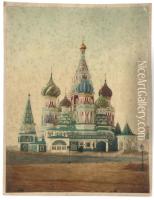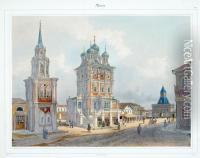Joseph Daziaro Paintings
Joseph Daziaro was born in 1806 in Moscow, Russia. Of Italian descent, Daziaro came from a family that was deeply involved in the arts and culture, which significantly influenced his career path. Despite the scarcity of detailed records about his early life and education, it is known that Daziaro developed a keen interest in art and lithography, eventually becoming one of the most prominent figures in the Russian art scene of the 19th century.
Daziaro's contribution to art is primarily marked by his work in lithography, a printing process that was relatively new at the time and allowed for the mass production of images. He was particularly known for his detailed and vivid depictions of Russian landscapes, architecture, and everyday life, offering a window into the 19th-century Russian Empire for both locals and foreigners. His works were not only artistic accomplishments but also valuable historical documents that captured the essence of Russian society during that period.
In the mid-19th century, Daziaro established a publishing house in Saint Petersburg, which became a significant cultural institution. The publishing house specialized in producing lithographs, maps, and books, many of which featured Daziaro's own artwork. His publications were highly sought after, not only in Russia but also among European and American collectors, contributing to his international reputation.
Throughout his career, Daziaro was dedicated to improving the technique of lithography, experimenting with different materials and methods to enhance the quality of his prints. His efforts paid off, as his works were celebrated for their clarity, detail, and artistic merit. Joseph Daziaro passed away in 1865, leaving behind a legacy that continued to influence Russian art and lithography. His sons continued his work, further solidifying the Daziaro family's impact on the Russian art world.
Daziaro's contributions to art and culture extend beyond his lithographs. He was instrumental in popularizing lithography in Russia, bringing attention to the potential of this medium as both an artistic and commercial venture. His depictions of Russian landscapes and scenes played a crucial role in shaping the visual narrative of Russia in the 19th century, making him an important figure in the history of Russian art.


